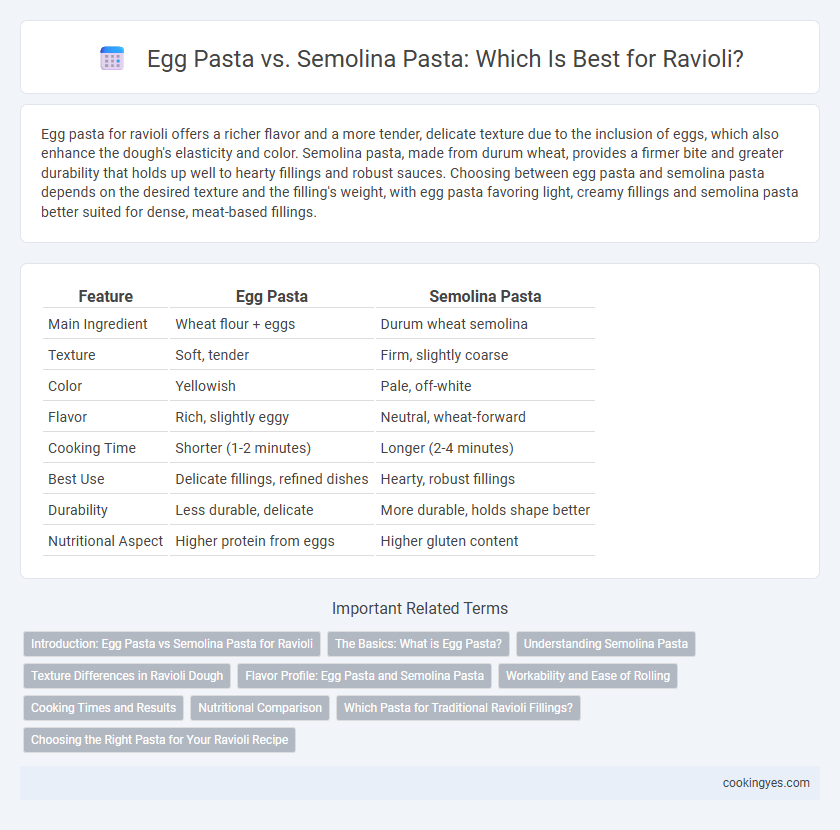Egg pasta for ravioli offers a richer flavor and a more tender, delicate texture due to the inclusion of eggs, which also enhance the dough's elasticity and color. Semolina pasta, made from durum wheat, provides a firmer bite and greater durability that holds up well to hearty fillings and robust sauces. Choosing between egg pasta and semolina pasta depends on the desired texture and the filling's weight, with egg pasta favoring light, creamy fillings and semolina pasta better suited for dense, meat-based fillings.
Table of Comparison
| Feature | Egg Pasta | Semolina Pasta |
|---|---|---|
| Main Ingredient | Wheat flour + eggs | Durum wheat semolina |
| Texture | Soft, tender | Firm, slightly coarse |
| Color | Yellowish | Pale, off-white |
| Flavor | Rich, slightly eggy | Neutral, wheat-forward |
| Cooking Time | Shorter (1-2 minutes) | Longer (2-4 minutes) |
| Best Use | Delicate fillings, refined dishes | Hearty, robust fillings |
| Durability | Less durable, delicate | More durable, holds shape better |
| Nutritional Aspect | Higher protein from eggs | Higher gluten content |
Introduction: Egg Pasta vs Semolina Pasta for Ravioli
Egg pasta for ravioli offers a rich, tender texture due to the inclusion of eggs, enhancing flavor and color, making it ideal for delicate fillings. Semolina pasta, made from durum wheat, provides a firmer, more elastic dough that holds up well to heartier fillings and boiling. Choosing between egg and semolina pasta depends on the desired ravioli texture and filling compatibility, with egg pasta favored in traditional Italian recipes and semolina preferred for robust durability.
The Basics: What is Egg Pasta?
Egg pasta for ravioli is made from a dough primarily consisting of wheat flour and whole eggs, providing a rich texture and a slightly yellow color. It offers a tender, delicate bite that enhances the filling's flavor while maintaining structural integrity during cooking. In contrast, semolina pasta, made from durum wheat semolina and water, has a firmer texture and a more neutral taste, lending ravioli a heartier bite ideal for robust fillings.
Understanding Semolina Pasta
Semolina pasta, made from durum wheat, offers a firmer texture and better elasticity compared to egg pasta, making it ideal for ravioli that require sturdy yet tender dough. The high gluten content in semolina provides resilience during cooking, preventing the pasta from becoming too soft or prone to breakage. Semolina pasta's slightly grainy texture enhances the overall mouthfeel, complementing rich fillings without overpowering their flavors.
Texture Differences in Ravioli Dough
Egg pasta ravioli dough offers a rich, tender texture with added elasticity due to the protein from eggs, resulting in a delicate yet resilient bite that holds fillings well. Semolina pasta dough provides a firmer, slightly coarse texture because of its higher gluten content and granulated structure, creating a more robust outer layer that withstands cooking without becoming overly soft. The choice between egg and semolina dough directly influences ravioli's mouthfeel and structural integrity during simmering, impacting the overall dining experience.
Flavor Profile: Egg Pasta and Semolina Pasta
Egg pasta offers a rich, creamy flavor with a tender texture that enhances the delicate fillings of ravioli, making it a popular choice for traditional Italian recipes. Semolina pasta provides a slightly nutty, robust taste with a firmer, chewier bite, which holds up well to hearty or rustic fillings. Choosing between egg and semolina pasta influences the overall taste and mouthfeel of ravioli, balancing richness against texture.
Workability and Ease of Rolling
Egg pasta for ravioli offers superior elasticity and smooth texture, making it easier to roll thin sheets without cracking. Semolina pasta, made from coarser durum wheat, provides a slightly firmer dough that requires more pressure during rolling but results in a chewier bite. The higher gluten content in semolina enhances structure but demands more skill to achieve the ideal thinness compared to the more pliable egg-based dough.
Cooking Times and Results
Egg pasta ravioli typically cooks faster, taking about 2 to 3 minutes, resulting in a tender and silky texture that complements rich fillings. Semolina pasta requires a longer cooking time, around 3 to 5 minutes, offering a firmer bite and more pronounced wheat flavor ideal for hearty or rustic fillings. Choosing between egg and semolina pasta affects both the cooking duration and the final mouthfeel, influencing the overall ravioli experience.
Nutritional Comparison
Egg pasta ravioli typically contains higher protein and fat content due to the inclusion of eggs, contributing to increased iron and vitamin A levels. Semolina pasta ravioli, made from durum wheat, offers more complex carbohydrates and dietary fiber, supporting sustained energy release and better digestive health. Both types provide essential nutrients, but egg pasta delivers more vitamins and minerals, while semolina pasta emphasizes fiber and carbohydrate quality.
Which Pasta for Traditional Ravioli Fillings?
Egg pasta, made from durum wheat flour and eggs, offers a rich flavor and tender texture ideal for traditional ravioli fillings like ricotta and spinach or meat mixtures. Semolina pasta, derived from coarser durum wheat, provides a firmer, chewier bite that holds up well to heartier fillings such as mushrooms or sausage. Choosing egg pasta enhances delicate fillings with a smooth, supple dough, while semolina pasta's robust structure is better suited for rustic, dense ravioli recipes.
Choosing the Right Pasta for Your Ravioli Recipe
Egg pasta offers a rich, tender texture ideal for delicate ravioli fillings, enhancing flavor through its higher protein content and smooth consistency. Semolina pasta, made from durum wheat, provides a firmer, chewier bite that holds up well to heartier or more robust fillings, making it perfect for rustic or dense ravioli recipes. Selecting between egg and semolina pasta depends on the desired balance of texture and flavor compatibility with the specific ravioli filling.
Egg pasta vs Semolina pasta for ravioli Infographic

 cookingyes.com
cookingyes.com